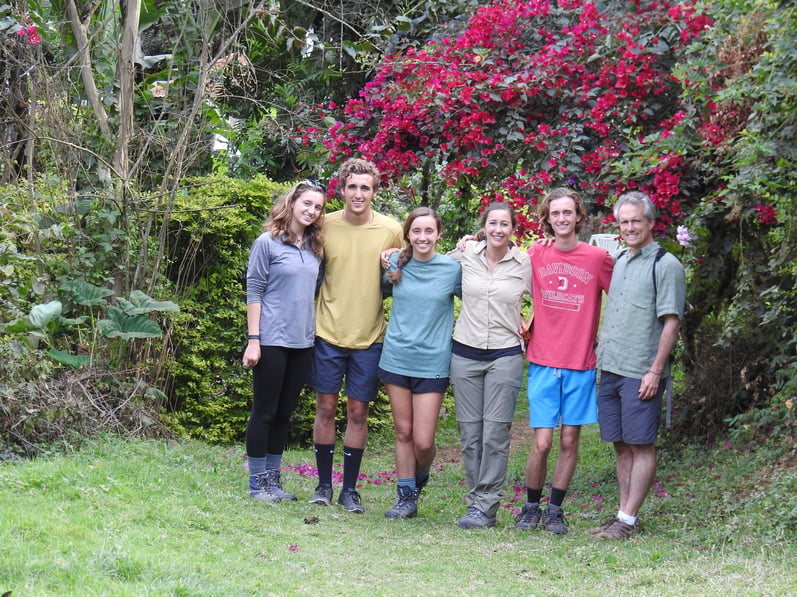 Sometimes intriguing information comes from unexpected sources.
Sometimes intriguing information comes from unexpected sources.
Of course, we expected to learn about animals and geology from Walter.
We were ready to learn about the Maasai, Hanzabe and Datogo people by visiting their tribes, speaking with them and observing their traditions.
These are well-cultivated experiences. You generally get the content that you desire and expect.
One walking tour was nothing like that.
Three days ago, our agenda said “coffee tour and tasting”. It included lunch. I do not know about you, but I expected to see some coffee plants, pick a few beans, learn about bean preparation, see a roaster and call it a day.

Of course, all of that happened, but that was just a mild augmentation to the true experience:
Walking with Sam through his village was the real show.

Sam is an engaging and bright product of a small village in the Arusha province. He attended the local school and now works for a couple (half Tanzanian, half Norwegian) that owns an organic coffee company that his family sells coffee to.
We arrived over 3 hours late for lunch after some craft shopping and haggling went way over schedule. [Note: we are not a family of shoppers. We do not particularly like the process. Also, we read some research a few years ago that suggests that it is better to spend money on experiences with people you value than on items. After a year, a new iPhone or car becomes an old iPhone or car and satisfaction levels drop. But a perfect dinner with a loved one or a morning hunt with an aboriginal tribe remain perfect even a year later. Functional MRIs of the brain show that when we remember positive experiences, they stimulate the brain in the same way that they did when first experienced them (albeit less intensely). That has led to our view of shopping on these trips – we strive to buy items that evoke a strong memory of a great experience. The metal arrowheads I bought from the Datogo tribe will take me back to their village. Our beaded Maasai chargers will remind us of playing soccer with their children. Since we do not like to shop, we steel ourselves and attempt to get major items like carved masks all knocked off in one focused session. On this day, the one session became two, but we knocked out the items on our list. The only downside of this “get it all done in one day” approach was that it made us 3 hours late for lunch and the tour.]
Below, Virginia expresses her enthusiasm about shopping (with her new friend). 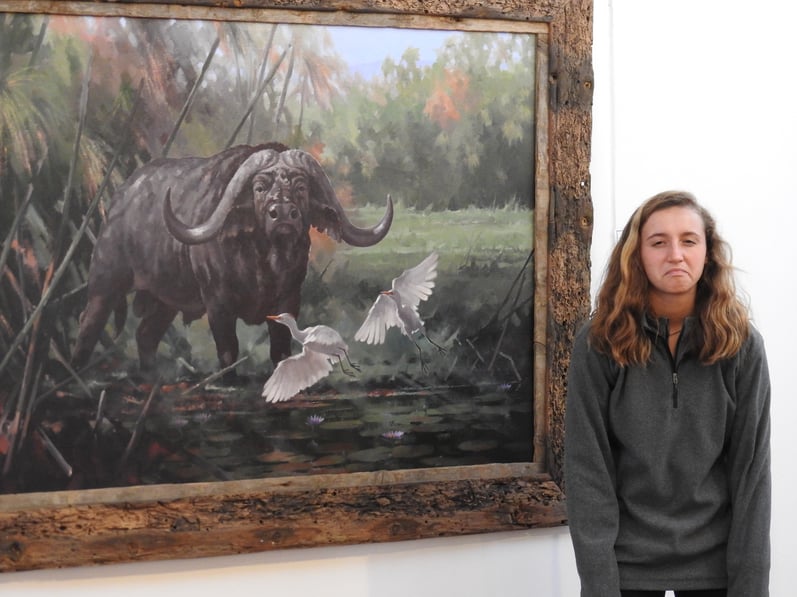
We had a delightful lunch with two notable tidbits: one fact and one story.
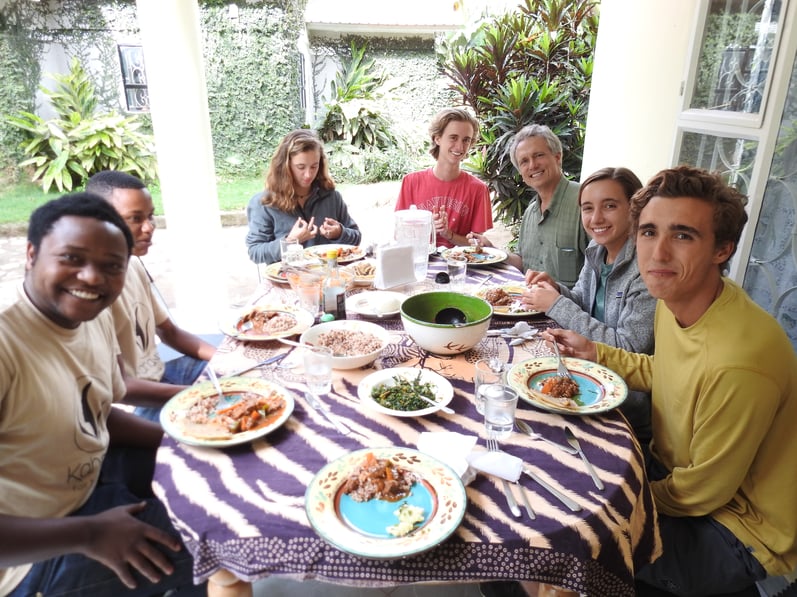
The fact is that avocados are everywhere here. You almost cannot give them away. Some people joke that they are dog food. An avocado here costs less than 2 cents. An apple, on the other hand, costs a dollar. Scarcity is an odd thing. These people who are awash in one of our favorite foods (we probably eat 6-10 each week) will typically not eat 2-3 a month.
The story came from Sam. Let me start by saying that I think he is telling the truth, though the story does stretch believability.
He visited Norway at the invitation of the owners of the coffee factory. He went to see the Northern Lights (nice, but too cold), but also to experience Nordic culture. He had seen enough of the Olympics to see snow skiing and asked to try it.
Being wise, the Norwegians gave him cross-country skis and told him to enjoy traversing the local area in a controlled, horizontal fashion. Given the next details of the story, I can only assume that the ski rental happened next to a ski mountain.
For those of you who are not skiers, let me briefly describe the difference between cross-country skis and downhill skis. Cross-country skis are very long, very thin and are attached only at the toe. The heel moves up and down to facilitate the walking motion of cross-country skiing. Think about what happens when a person is on a NordicTrack. Downhill skis are much shorter, wider, shaped to facilitate turning and the entire foot is locked into the ski. Essentially everything about the downhill ski is designed to facilitate safe and controlled turns. Speed is nice, but there is also a lot to be said for avoiding trees, cliffs and other skiers. Cross-country skis have no need for turning since this activity is generally straight and on flat land. The one time I cross-country skied was with Susie’s dad Wiley on a golf course. It was fine except for a 20-foot section that was a distinct, but gentle downgrade. I am a good skier, but I felt out of control for those 20 feet.]
Anyway, Sam is at the ski resort with cross-country skis and watching other people going slowly and happily on flat trails. But he knows better – he’s seen the Olympics. REAL skiing is downhill with graceful turns and speedy descents. He then makes a decision that should not have ended as well as it did.
He decided to get on a lift and ride to the top of a mountain.
In his retelling, he stressed that the Norwegians spent a LOT of time staring at him and trying to decide exactly what they were looking at. Was this some international skiing superstar preparing to hone his skills? Because the Norwegians are unfailingly polite, no one actually asked him.
He got to the top and watched as people started to ski. The terrain started flat for the first 10-15 feet and then dropped into a much steeper grade. He poled himself to the edge, took a deep breath and then pointed the skis downhill.
We can only assume that Sam has superior balance, because he managed to stay upright as his skis gathered speed and darted downhill.
While he managed to stay upright, he quickly discovered that he had no idea how to turn. The graceful arcs he had seen on the TV were utterly unavailable to him. What was available was an arrow straight descent at ever increasing speeds.
He estimated that he approached 80 kilometers/hour (50 MPH). That actually sounds like exactly what I would guess if very long, very straight skis were allowed to take a 200 lbs human on a direct route downhill.
I was waiting to hear him describe the resulting “yard sale” (when you fall so hard that your skis, poles, gloves and headgear all scatter around you, looking like a yard sale).
But this was not the way the first flight of Sam the Tanzania Terror would end.
He then told us about the restaurant.
Often restaurants are placed at the bottom of a ski hill so that skiers can pop off their skis and go inside for meal or hot chocolate. They are intentionally in the middle of the traffic pattern. While I have not ever thought about it before, they are kinda in the way. Their placement works on the essential, but suddenly erroneous, assumption that the skier can turn or stop.
In front of the restaurant was a bench/snow drift that separated it from the slope. Its official purpose was unclear to Sam (and thus unclear to us). But the de facto purpose would soon become evident as our novice Nordic speedster barreled into it.
The “bench” became a ramp.
I was delighted to hear that the bench was not a true bench. My mind’s eye pictured 1) his skis/feet under the bench, 2) his upper body above the bench and 3) his calved staying with the bench. Imagine the scene in “Misery” when Kathy Bates snaps James Caan’s ankle, except without the subtlety.
But, as I said, it was a ramp, not a bench.
Sam soared.
Soar, Sam, soar.
He took off and touched the top of the restaurant and continued over the other side, landed briefly on the far side of the highway (narrowly avoiding a truck) and then continued onto the lake.
As he landed on the frozen lake and stopped, he felt pain from the impact and was suddenly struck with fear.
Did he fear the flight he just took? No. Was it the truck he missed? Nope.
Perhaps he was concerned that he would go into the water and die of hyperthermia. Maybe he realized that his mediocre swimming skills were not sufficient given the heavy amount of gear he had.
That would have terrified me, but these were not the thoughts that haunted Sam.
You see, Sam had recently seen Jaws. He was worried about being eaten by a fish.
I could not make that up if I had to.
Happily, ice did not break, so San did not encounter the dreaded Scandinavian fresh-water shark.
And he lived to tell the tale.
If this story is not true, I really do not want to know that. I will go with the words of Tommy Lee Jones in “No Country for Old Men” when asked “Is that story true?”
“Its true that it's a story.”
After we all stopped laughing, we started a tour of his village. We saw a modest school that had 6 classrooms and served 1000 students in groups of 160. They had one book for every 10 students. He then told us about how teachers maintained order when so outnumbered.
Lashes.
If you talked in class, arrived late or failed to do homework, you received lashes. He received over 1000 in his experience (as I said in the blog about Mandy’s academy).
When then walked through the city. We walked by a rectangular, concrete building.
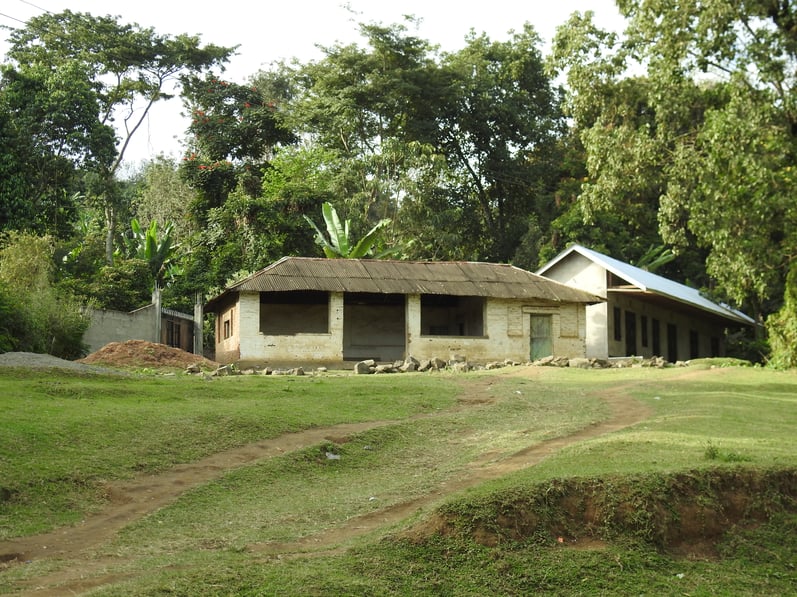
“That is the courthouse. That is where you can solve disputes.”
Being the son of a judge, I pictured lawyers, a judge and perhaps a jury.
“If a husband argues with his wife and disturbs the neighbors, they can bring him here and he will get 50 lashes. If someone is too drunk, they can bring him here and he will get 70 lashes.
“Two years ago, the boys started to wear their pants loose and low with their underwear showing. The local council did not like this. Now, if your underwear shows, you come here.”
“Let me guess,” speculated Wiley. “Lashes?”
“Yes, 100 lashes.”
We learned of the various forms of lashes. This is a serious cultural difference from the US. I wanted to explain all the ways you can manage children without hitting them, but this tour was about educating us about Tanzanian village life, not about Camp Champions discipline theory.
Here the boys are practicing a Tanzania life skill.

We also saw something else unusual. Sam reached down and picked up a plastic packet that was 3 inches tall and 2 inches wide. It said “London Dry”.
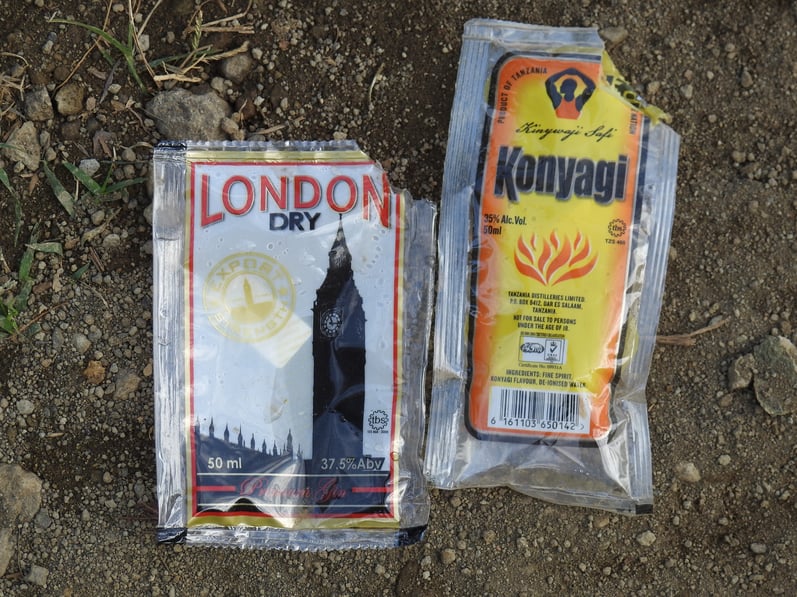
It had contained roughly half a shot of gin before the owner had consumed it and dropped it on the ground. Apparently, this is a big problem in these villages. People sneak these packets into their clothes and pop a drink whenever they want.
This is a packaging idea that had simply never occurred to me (and, might I add, for good reason). Our tour ran long, so we were still walking after sunset. It was then that we began to see some of the consumers of this product. One man shook my hand and asked to have his picture taken with me. I smelled the gin, but wanted to be polite. After the picture, he demanded payment (which I withheld).
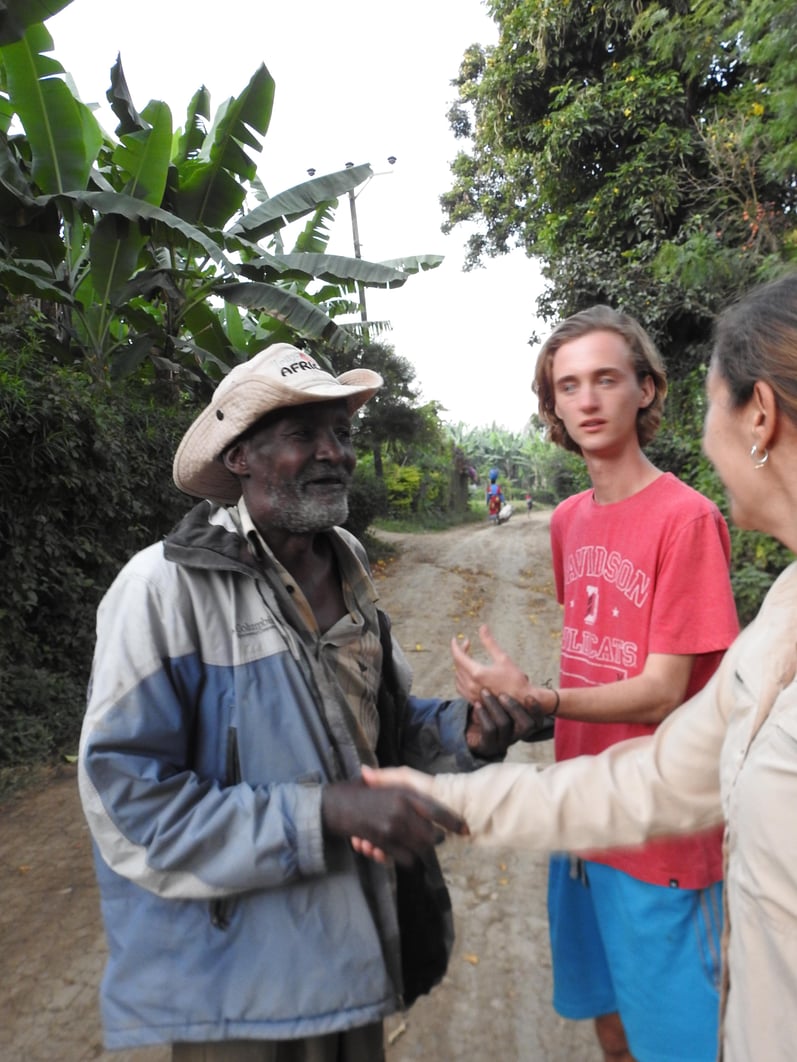
All this made Susie nervous while it appealed to Liam’s sense of adventure. THIS was not in the brochures or travel guides. This was real life.
We finally returned to the coffee factory to find a very concerned Walter. We conducted the shortest coffee tasting in the free world and headed on to see the School of St Jude’s.
Steve Sir
PS As we walked, we came across a view of Mt Kilimanjaro. We would later learn that this is a rare site, so we share it here.


